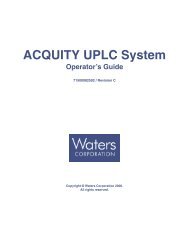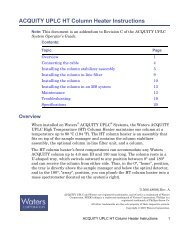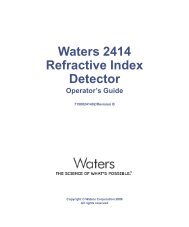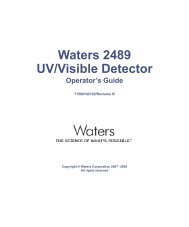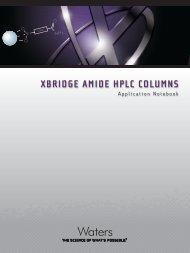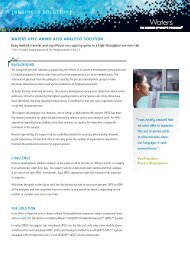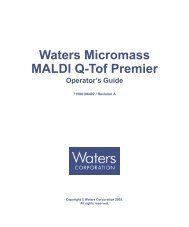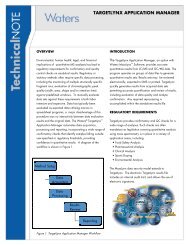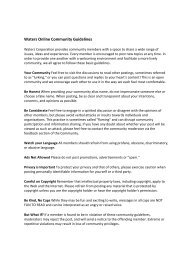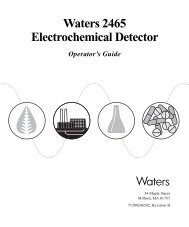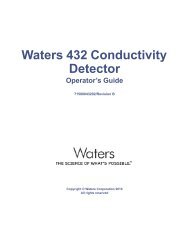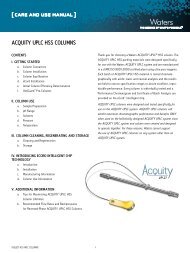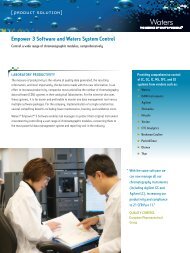nanoACQUITY UPLC System Solvent Stabilization Kit ... - Waters
nanoACQUITY UPLC System Solvent Stabilization Kit ... - Waters
nanoACQUITY UPLC System Solvent Stabilization Kit ... - Waters
You also want an ePaper? Increase the reach of your titles
YUMPU automatically turns print PDFs into web optimized ePapers that Google loves.
<strong>nanoACQUITY</strong> <strong>UPLC</strong> <strong>System</strong><br />
<strong>Solvent</strong> <strong>Stabilization</strong> <strong>Kit</strong> Instructions<br />
Contents:<br />
Topic<br />
Page<br />
Materials and tools required 1<br />
Installing the solvent stabilization kit 2<br />
Making the solvent connections 3<br />
Making the gas connections 5<br />
Operation 7<br />
Troubleshooting 9<br />
<strong>Solvent</strong> stabilization kit on solvent tray 11<br />
This kit modifies a <strong>nanoACQUITY</strong> <strong>UPLC</strong> ® system that includes a mass<br />
spectrometer so that you can sparge or blanket solvents with helium.<br />
See also: <strong>nanoACQUITY</strong> <strong>UPLC</strong> <strong>System</strong> Operator’s Guide and the MassLynx<br />
online Help.<br />
Materials and tools required<br />
• Helium source (highest purity) with a regulated output between 90 and<br />
100 psi<br />
• One or two solvent bottles, up to a maximum volume of 1 L, with GL45<br />
DIN thread, per ISO 4796<br />
Warning: This kit is designed for use with solvent bottles no<br />
larger than 1000 mL.<br />
• Phillips ® screwdriver<br />
• Razor knife<br />
715001669, Rev. A<br />
<strong>nanoACQUITY</strong> <strong>UPLC</strong> and <strong>Waters</strong> are registered trademarks, and<br />
“THE SCIENCE OF WHAT’S POSSIBLE” is a trademark of <strong>Waters</strong> Corporation.<br />
Phillips is a registered trademark of The Phillips Screw Company.<br />
Snoop is a registered trademark of Swagelok Company.<br />
Teflon is a registered trademark of E. I. du Pont de Nemours and Company.<br />
All other trademarks are the sole property of their respective owners.<br />
Copyright © 2008 <strong>Waters</strong> Corporation.<br />
1
Installing the solvent stabilization kit<br />
The regulator assembly mounts on the right-hand rail of the solvent tray.<br />
See also: “<strong>Solvent</strong> stabilization kit on solvent tray” on page 11<br />
Warning: To prevent injury, always observe Good Laboratory<br />
Practices when you handle solvents, change tubing, or operate the<br />
system. Know the physical and chemical properties of the solvents you<br />
use. See the Material Safety Data Sheets for the solvents in use.<br />
Caution: To avoid contaminating the system with skin oils, powder, or<br />
other contaminants, always wear powder-free, sterile gloves when<br />
handling the tubing, fittings, and other system components.<br />
See also: Controlling Contamination in UltraPerformance LC/MS<br />
and HPLC/MS <strong>System</strong>s.<br />
To attach the regulator assembly to the solvent tray<br />
1. Locate the regulator assembly on a vertical part of the right-hand rail of<br />
the solvent tray.<br />
Recommended locations<br />
Regulator<br />
assembly on<br />
right rear of<br />
solvent tray<br />
To helium<br />
source<br />
Alternate placement<br />
Front of solvent tray<br />
2 715001669 rA
2. To mount the regulator, remove one screw from the C-clamp, and swing<br />
the clamp out of the way.<br />
Attaching the regulator to the solvent tray<br />
Gas outlet<br />
Bracket<br />
Gas inlet<br />
Bracket<br />
Pressure relief valve<br />
C-clamp<br />
3. Holding the C-clamp on the outside of the rail and the bracket on the<br />
inside, attach the bracket and C-clamp using the two screws.<br />
Making the solvent connections<br />
To make the solvent connections:<br />
1. Determine the volume of the solvent bottles.<br />
• If you use 1000-mL bottles, proceed to step 2.<br />
• If you use 500-mL bottles, trim approximately 10 cm (4 inches) from<br />
the end of each of the three Teflon tubing lines under the bottle<br />
caps. If later required, you can replace the lines using 1/8-inch OD ×<br />
1/16-inch ID Teflon tubing.<br />
2. On a bottle cap, select one of the three ports to which tubing is attached,<br />
and install a check valve on the top of the cap, securing it finger tight.<br />
Restriction: The bottle caps have four ports. Three ports have tubing<br />
attached to the underside of the cap. The fourth port does not have<br />
tubing attached to its underside and must remain unused. This port<br />
allows you to switch between sparging and blanketing.<br />
715001669 rA 3
Installing the bubbler filter and check valve<br />
<strong>Solvent</strong> ports<br />
Bottle cap check valve<br />
Check valve port<br />
Bottle cap shutoff<br />
valves<br />
Unused port with no<br />
tubing attached to<br />
underside of bottle cap<br />
Teflon tubing<br />
for solvents<br />
Teflon tubing for gas<br />
Bubbler filter<br />
3. Slide the bubbler filter onto the tubing that connects to the check valve<br />
port. Ensure the bubbler filter and the check valve are attached to the<br />
same port on the bottle cap.<br />
4. Remove the solvent filters from the ends of the tubing connected to the<br />
solvent inlets in the solvent manager.<br />
5. Slide the solvent filters onto the ends of the tubing connected to the<br />
solvent ports.<br />
6. Connect the solvent tubing from the solvent manager to the solvent<br />
ports on top of the bottle cap.<br />
7. Cut the bottle netting to a length equal to the bottle height:<br />
• 500-mL reservoir: approximately 17 cm (6.5 inches)<br />
• 1000-mL reservoir: approximately 22 cm (8.5 inches)<br />
8. Slide the netting over the bottle neck and downward toward the base.<br />
Rationale: The protective polyethylene netting prevents the bottles from<br />
surface damage. The netting is suitable for 500- and 1000-mL bottles<br />
that are less than 10 cm (4 inches) in diameter.<br />
9. Repeat steps 1 through 8 for the second bottle.<br />
10. Screw the cap assemblies onto the bottles.<br />
4 715001669 rA
Making the gas connections<br />
To make the gas connections:<br />
1. Cut a section of tubing 13 to 15 cm (5 to 6 inches) long, and connect it<br />
between the gas outlet of the regulator assembly and the in-line check<br />
valve.<br />
Tip: The check valve uses the blue nut and clear tapered ferrule.<br />
Requirement: The arrow on the check valve indicates the direction of<br />
gas flow. Install the check valve with the arrow pointing away from the<br />
regulator. Otherwise, helium cannot flow to the solvent bottles.<br />
2. Cut a section of tubing 5 to 7 cm (2 to 3 inches) long, and connect it<br />
between the in-line check valve and the Y-fitting, as shown below.<br />
Tip: The Y-fitting uses tapered ferrules and large nuts.<br />
Y-fitting connections<br />
Gas tubing<br />
from helium<br />
source<br />
Blue nut<br />
In-line check valve<br />
Blue nut<br />
Tapered ferrule<br />
Gas tubing<br />
Large nut<br />
Y-fitting<br />
Gas tubing to<br />
check valve on<br />
solvent bottle caps<br />
715001669 rA 5
Regulator connections<br />
Gas outlet<br />
Regulator knob<br />
Gas inlet<br />
(PEEK fitting)<br />
Warning: For safety reasons, the pressure is set to<br />
approximately 4.5 psi. If tampering occurs, the pressure relief<br />
valve can open.<br />
3. Cut a section of tubing 46 to 51 cm (18 to 20 inches) long, and connect it<br />
between the Y-fitting and the bottle cap check valve. Repeat for the<br />
second bottle.<br />
Requirement: Make the connections at the regulator assembly using the<br />
PEEK fittings and non tapered ferrules, as shown below.<br />
Regulator connections<br />
PEEK fitting on regulator<br />
Non tapered ferrule<br />
Large nut<br />
Gas tubing from helium source<br />
4. Attach the helium source to the gas inlet of the regulator assembly.<br />
Alternatives: If needed, use the balance of gas tubing supplied in the kit<br />
to connect the regulator to the helium source. To accommodate various<br />
helium sources, this kit includes a 1/8-inch NPT fitting and a 1/8-inch to<br />
1/4-inch bushing. Use a non tapered ferrule.<br />
6 715001669 rA
5. Visually inspect the connections on the bottle caps to ensure that these<br />
conditions are met:<br />
• The gas supply lines from the Y-fitting are connected to the check<br />
valve on each bottle cap, which is in line with the bubbler filter.<br />
• All solvent supply lines are connected to ports that have tubing with<br />
solvent filters in the bottles.<br />
• The port with no tubing is unused.<br />
Operation<br />
Caution:<br />
• The in-line check valve prevents solvent from flowing back to the<br />
regulator. Before operating the system, verify that all lines are free<br />
of liquid.<br />
• To ensure proper operation, the helium source pressure must be<br />
between 90 and 100 psi.<br />
• The valve at the check valve on the bottle cap serves as a disconnect<br />
between the helium source and the solvent system. When filling the<br />
solvent bottles or changing the helium source, close this valve.<br />
• When initially supplying helium to the regulator assembly, close the<br />
bottle cap shutoff valves, and reopen them only after you open the<br />
helium source valve.<br />
To operate:<br />
1. Open the helium source. Ensure that the pressure is between 90 and<br />
100 psi.<br />
2. Open the bottle cap shutoff valves to sparge the solvents.<br />
See also: “To sparge the solvents:” on page 8.<br />
3. To blanket the solvents, close the shutoff valve for the port that has no<br />
tubing attached to the underside of the bottle cap.<br />
See also: “To blanket the solvents:” on page 9.<br />
715001669 rA 7
To add solvents to the bottles:<br />
1. Ensure that the solvent flow is stopped.<br />
2. Close all bottle cap shutoff valves (horizontal position).<br />
Tip: Each bottle cap has four ports. Fitted to each port is an<br />
independent-acting shutoff valve. When the valve handle is horizontal,<br />
the integral cap valve is closed. When the handle is vertical, the shutoff<br />
valve is open.<br />
3. Remove the cap assembly from the bottle.<br />
4. Fill the bottle with solvent.<br />
5. Screw the cap assembly onto the bottle.<br />
6. Open all bottle cap shutoff valves.<br />
7. Sparge the solvent.<br />
See also: “To sparge the solvents:” on page 8.<br />
8. Blanket the solvent.<br />
See also: “To blanket the solvents:” on page 9.<br />
9. Start the solvent flow.<br />
To sparge the solvents:<br />
1. Ensure that the helium source is between 90 and 100 psi.<br />
2. Open all bottle cap shutoff valves.<br />
8 715001669 rA
Bottle cap valves during sparging<br />
Open shutoff<br />
valves for<br />
solvent supply<br />
Open shutoff valve at<br />
check valve port<br />
The port with no tubing attached to the<br />
underside of the bottle cap must remain<br />
unused.<br />
To blanket the solvents:<br />
1. Ensure that the helium source is between 90 and 100 psi.<br />
2. Close the shutoff valve at the unused port (horizontal position), and<br />
ensure that all the other port valves are open.<br />
To replace the helium source:<br />
1. Ensure that the solvent flow is stopped.<br />
2. Close all bottle cap shutoff valves (horizontal position).<br />
3. Disconnect the gas tubing from the depleted helium source.<br />
4. Connect the gas tubing to a source of helium.<br />
5. Ensure that the helium source pressure is between 90 and 100 psi.<br />
6. Open the bottle cap shutoff valves to sparge the solvents.<br />
7. To blanket the solvents, close the shutoff valve at the port that has no<br />
tubing attached to the underside of the bottle cap.<br />
Troubleshooting<br />
Warning: For safety reasons, do not adjust the regulator. It is<br />
factory-adjusted to the optimum setting.<br />
715001669 rA 9
Caution: If the internal pressure rises above the default value<br />
(approximately 4.5 psi), the pressure relief valve partially opens.<br />
At approximately 10 psi, the pressure relief valve allows<br />
100% venting.<br />
Symptom Possible cause Solution<br />
Gas is consumed too<br />
quickly<br />
Hissing from pressure<br />
relief valve (Pressure<br />
relief valve goes to<br />
100% venting at about<br />
10 psi, which is about<br />
twice the default<br />
setting.)<br />
No gas flow<br />
Unable to sparge<br />
Leaks from the gas<br />
connections or tubing<br />
Excessive sparging;<br />
regulator setting<br />
accidentally increased<br />
Regulator setting<br />
accidentally increased<br />
Bottle cap shutoff valve<br />
at check valve port<br />
closed<br />
Helium source turned<br />
off or depleted<br />
Regulator accidentally<br />
decreased<br />
Unused shutoff valve<br />
on cap closed<br />
Helium source empty<br />
Use a leak detector<br />
such as snoop ® to detect<br />
any leaks in the gas<br />
connections or tubing.<br />
Adjust the regulator to<br />
the required 4.5 psi.<br />
Adjust the regulator to<br />
the required 4.5 psi.<br />
Open bottle cap shutoff<br />
valve at check valve<br />
port.<br />
Ensure that the helium<br />
source pressure is<br />
between 90 and 100 psi.<br />
Replace helium supply.<br />
Adjust the regulator to<br />
the required 4.5 psi.<br />
Ensure that the helium<br />
source pressure is<br />
between 90 and 100 psi.<br />
Open unused shutoff<br />
valve on bottle cap.<br />
Replace helium source.<br />
10 715001669 rA
<strong>Solvent</strong> stabilization kit on solvent tray<br />
Suggested installation layout<br />
715001669 rA 11
12 715001669 rA



![[ TIPS ] [ ACQUITY UPLC SYSTem QUICk START CARD ] - Waters](https://img.yumpu.com/51427825/1/190x245/-tips-acquity-uplc-system-quick-start-card-waters.jpg?quality=85)
